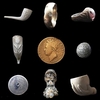Museum of London Archaeology specialist Han Li lays out plaster fragments present in London from a Roman constructing that was demolished a while earlier than A.D. 200.
©MOLA/Museum of London Archaeology
disguise caption
toggle caption
©MOLA/Museum of London Archaeology
LONDON — A outstanding archaeological endeavor within the coronary heart of the British capital has dropped at gentle probably the most in depth collections of painted Roman wall plaster ever unearthed within the metropolis.
1000’s of vibrant fragments, which as soon as adorned a high-status Roman constructing, supply an unprecedented glimpse into the inventive sophistication and day by day lifetime of historical Londinium, and their rearrangement is showcasing artworks which have remained hidden for over 1,800 years.
The invention, made at “The Liberty” growth website within the metropolis’s Southwark neighborhood, builds upon earlier important finds within the space, together with intricate mosaics and a uncommon Roman mausoleum.

The sheer quantity of the plaster fragments, nonetheless, was not instantly obvious to archaeologists.
The fabric was discovered discarded in a large pit, shattered as a consequence of Roman-era demolition actions that occurred earlier than A.D. 200.
The painstaking technique of reassembling these fragments has been a monumental enterprise, specialists say, akin to fixing an immense historic puzzle.
Main this intricate reconstruction effort was the Museum of London Archaeology (MOLA) the place Han Li, the senior constructing materials specialist, spent three months meticulously laying out and piecing collectively the fragments.

The result’s a shocking restoration that permits these historical frescoes to be considered of their unique splendor for the primary time in almost two millennia.
“This has been a ‘as soon as in a lifetime’ second, so I felt a mixture of pleasure and nervousness after I began to put the plaster out,” Li stated in a MOLA press launch.

Sections of floral ornament are seen on the Liberty wall plaster. The recovered artworks depict brilliant yellow panel designs interspersed with black sections, exquisitely embellished with motifs of birds, fruit, flowers and lyres.
©MOLA/Museum of London Archaeology
disguise caption
toggle caption
©MOLA/Museum of London Archaeology
“Most of the fragments had been very delicate and items from totally different partitions had been jumbled in when the constructing was demolished,” effectively earlier than the Romans had deserted Britain as their empire started to recede, he stated. “The consequence was seeing wall work that even people of the late Roman interval in London wouldn’t have seen.”
The recovered artworks depict brilliant yellow panel designs interspersed with black sections, exquisitely embellished with motifs of birds, fruit, flowers and lyres.

Such panel designs had been a typical function in Roman wall ornament, in keeping with MOLA, however the prevalence of yellow panels was uncommon. Comparable designs have been recognized at solely a handful of web sites throughout Britain, together with the opulent Fishbourne Roman Palace, about 60 miles to the southwest of this website.
Past their aesthetic enchantment, the fragments supply distinctive insights into Roman artistry and literacy. Among the many greater than 120 containers of painted plaster, archaeologists uncovered what seems to be the primary identified instance of a painter’s signature in Roman Britain.
![Framed by a tabula ansata — a decorative tablet that’s typically used to sign artworks — an inscription includes the Latin word 'FECIT,' meaning "has made [this]."](https://npr.brightspotcdn.com/dims3/default/strip/false/crop/7050x3711+0+0/resize/1100/quality/50/format/jpeg/?url=http%3A%2F%2Fnpr-brightspot.s3.amazonaws.com%2F48%2Fda%2Fc64b9abd4d43aa026d36734e3cce%2Fthe-remains-of-the-tabula-ansata-mola-museum-of-london-archaeology.jpg)
Framed by a tabula ansata — an ornamental pill that is sometimes used to signal artworks — an inscription contains the Latin phrase ‘FECIT,’ which means “has made [this].”
©MOLA/Museum of London Archaeology
disguise caption
toggle caption
©MOLA/Museum of London Archaeology
Framed by a tabula ansata — an ornamental pill that is sometimes used to signal artworks — the inscription contains the Latin phrase ‘FECIT,’ which means “has made [this].” However the part bearing the artist’s title is lacking, leaving their id a thriller.
Additional intriguing particulars embody historical graffiti left by the constructing’s occupants or guests. One fragment incorporates a almost full historical Greek alphabet, the one identified occasion of such an inscription from Roman Britain.
The exact scoring of the letters suggests a talented hand, indicating it was not merely writing apply however probably served a sensible goal, similar to a guidelines or reference. One other piece reveals the face of a weeping lady, depicted with a coiffure attribute of the Flavian interval, which dated from A.D. 69-96.

The inventive influences evident in these frescoes lengthen past Britain, drawing inspiration from wall decorations present in different elements of the Roman Empire, similar to Xanten and Cologne in Germany, and Lyon in France. Some fragments even mimic high-status wall tiles, similar to crimson Egyptian porphyry and African giallo antico marble, kinds additionally seen in Londinium north of the River Thames, the southern English city of Colchester, and Pompeii in Italy.
London was initially based as a metropolis — Londinium — quickly after the Roman invasion in A.D. 43, and has persistently yielded important archaeological treasures. Lately, quite a few excavations have unearthed remnants of Roman roads, buildings and artifacts, constantly reshaping historians’ understanding of this historical metropolis.
The sheer scale and element of the Southwark plaster assortment present an unparalleled alternative, in keeping with MOLA, to check Roman home artwork and the lives of its inhabitants.

Analysis into every plaster piece is ongoing, with Han Li and his MOLA colleagues persevering with to investigate the work of those historical painters. Their efforts will contain evaluating the Liberty wall work with different examples from Britain and the broader Roman world.
The findings shall be revealed, and the fragments archived for future tutorial research, with plans for eventual public show, permitting up to date audiences to witness these extraordinary inventive legacies from a bygone period.









